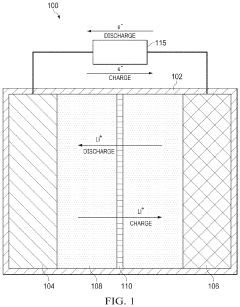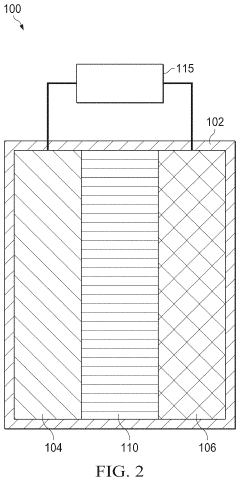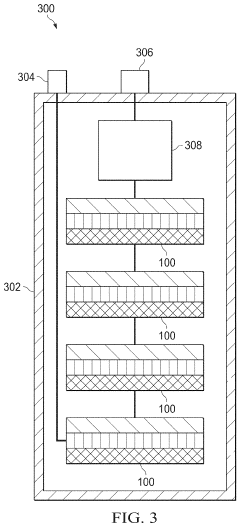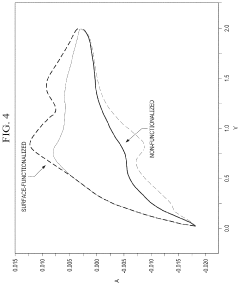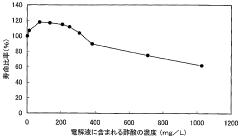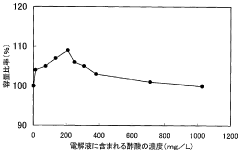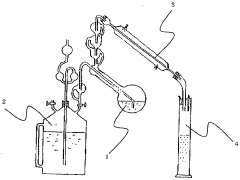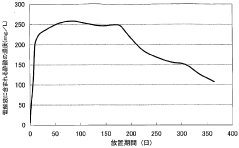How Battery Acid Enhances Energy Harvesting Efficiency
AUG 4, 20259 MIN READ
Generate Your Research Report Instantly with AI Agent
Patsnap Eureka helps you evaluate technical feasibility & market potential.
Battery Acid EH Background
Energy harvesting has emerged as a promising technology for sustainable power generation, particularly in applications where traditional power sources are impractical or insufficient. In recent years, researchers have been exploring innovative ways to enhance the efficiency of energy harvesting systems, with a particular focus on the role of battery acid in this process.
The concept of using battery acid to improve energy harvesting efficiency stems from the fundamental principles of electrochemistry and the unique properties of electrolytes. Battery acid, typically a solution of sulfuric acid, has long been a crucial component in lead-acid batteries, where it facilitates the conversion of chemical energy into electrical energy. However, its potential in energy harvesting systems extends beyond traditional battery applications.
The exploration of battery acid in energy harvesting can be traced back to early experiments in thermoelectric generators and piezoelectric devices. Researchers observed that the presence of certain electrolytes could significantly enhance the charge transfer and ion movement within these systems, leading to improved energy conversion rates. This discovery prompted further investigation into the specific role of battery acid and its potential to optimize various energy harvesting technologies.
One of the key advantages of incorporating battery acid into energy harvesting systems is its ability to increase the conductivity of the harvesting medium. The highly ionized nature of battery acid allows for more efficient charge transfer, reducing internal resistance and minimizing energy losses. This property is particularly beneficial in thermoelectric and electrochemical energy harvesting applications, where the movement of ions plays a crucial role in energy conversion.
Moreover, battery acid has shown promise in enhancing the durability and longevity of energy harvesting devices. The corrosion-resistant properties of certain acid formulations can protect sensitive components from degradation, ensuring sustained performance over extended periods. This aspect is especially important in remote or hard-to-reach installations where frequent maintenance is not feasible.
The integration of battery acid in energy harvesting systems also opens up new possibilities for hybrid energy storage solutions. By combining the energy harvesting capabilities with the inherent energy storage properties of battery acid, researchers are developing more efficient and compact power systems. These hybrid solutions offer the potential for continuous energy supply, even in environments with intermittent energy sources.
As the field of energy harvesting continues to evolve, the role of battery acid in enhancing efficiency is becoming increasingly significant. Ongoing research is focused on optimizing acid compositions, exploring novel electrode materials, and developing advanced control systems to maximize the benefits of battery acid in various energy harvesting applications. The potential impact of these advancements extends across multiple sectors, including wearable technology, remote sensing, and sustainable energy infrastructure.
The concept of using battery acid to improve energy harvesting efficiency stems from the fundamental principles of electrochemistry and the unique properties of electrolytes. Battery acid, typically a solution of sulfuric acid, has long been a crucial component in lead-acid batteries, where it facilitates the conversion of chemical energy into electrical energy. However, its potential in energy harvesting systems extends beyond traditional battery applications.
The exploration of battery acid in energy harvesting can be traced back to early experiments in thermoelectric generators and piezoelectric devices. Researchers observed that the presence of certain electrolytes could significantly enhance the charge transfer and ion movement within these systems, leading to improved energy conversion rates. This discovery prompted further investigation into the specific role of battery acid and its potential to optimize various energy harvesting technologies.
One of the key advantages of incorporating battery acid into energy harvesting systems is its ability to increase the conductivity of the harvesting medium. The highly ionized nature of battery acid allows for more efficient charge transfer, reducing internal resistance and minimizing energy losses. This property is particularly beneficial in thermoelectric and electrochemical energy harvesting applications, where the movement of ions plays a crucial role in energy conversion.
Moreover, battery acid has shown promise in enhancing the durability and longevity of energy harvesting devices. The corrosion-resistant properties of certain acid formulations can protect sensitive components from degradation, ensuring sustained performance over extended periods. This aspect is especially important in remote or hard-to-reach installations where frequent maintenance is not feasible.
The integration of battery acid in energy harvesting systems also opens up new possibilities for hybrid energy storage solutions. By combining the energy harvesting capabilities with the inherent energy storage properties of battery acid, researchers are developing more efficient and compact power systems. These hybrid solutions offer the potential for continuous energy supply, even in environments with intermittent energy sources.
As the field of energy harvesting continues to evolve, the role of battery acid in enhancing efficiency is becoming increasingly significant. Ongoing research is focused on optimizing acid compositions, exploring novel electrode materials, and developing advanced control systems to maximize the benefits of battery acid in various energy harvesting applications. The potential impact of these advancements extends across multiple sectors, including wearable technology, remote sensing, and sustainable energy infrastructure.
Market Analysis for EH
The energy harvesting (EH) market has been experiencing significant growth in recent years, driven by the increasing demand for sustainable and autonomous power sources across various industries. The global energy harvesting market size was valued at approximately $460 million in 2020 and is projected to reach $1.2 billion by 2026, growing at a CAGR of 17.4% during the forecast period.
The market for energy harvesting technologies is segmented based on energy sources, including mechanical, thermal, light, electromagnetic, and others. Among these, mechanical energy harvesting holds the largest market share, followed by thermal and light energy harvesting. The integration of battery acid in energy harvesting systems has the potential to enhance efficiency across all these segments.
Key industries driving the adoption of energy harvesting technologies include consumer electronics, industrial, building and home automation, transportation, and healthcare. The consumer electronics sector, in particular, has shown substantial growth in the adoption of energy harvesting solutions, with applications in wearable devices, smartphones, and IoT sensors.
The industrial sector is another significant market for energy harvesting, with applications in predictive maintenance, remote monitoring, and industrial IoT. The use of battery acid-enhanced energy harvesting systems in this sector could lead to improved efficiency and longer operational lifetimes for industrial sensors and devices.
Geographically, North America and Europe are the leading markets for energy harvesting technologies, owing to the presence of key players, advanced infrastructure, and supportive government initiatives. However, the Asia-Pacific region is expected to witness the highest growth rate in the coming years, driven by rapid industrialization, increasing adoption of IoT devices, and growing investments in smart city projects.
The market landscape for energy harvesting is characterized by intense competition and continuous innovation. Key players in the market include Texas Instruments, STMicroelectronics, EnOcean GmbH, Powercast Corporation, and Cymbet Corporation. These companies are actively investing in research and development to improve the efficiency and applicability of energy harvesting technologies.
The integration of battery acid in energy harvesting systems represents a potential game-changer in the market. This innovation could address some of the key challenges faced by current energy harvesting technologies, such as low power output and limited storage capacity. As a result, it may open up new application areas and market opportunities, particularly in sectors requiring higher power outputs or longer operational durations.
The market for energy harvesting technologies is segmented based on energy sources, including mechanical, thermal, light, electromagnetic, and others. Among these, mechanical energy harvesting holds the largest market share, followed by thermal and light energy harvesting. The integration of battery acid in energy harvesting systems has the potential to enhance efficiency across all these segments.
Key industries driving the adoption of energy harvesting technologies include consumer electronics, industrial, building and home automation, transportation, and healthcare. The consumer electronics sector, in particular, has shown substantial growth in the adoption of energy harvesting solutions, with applications in wearable devices, smartphones, and IoT sensors.
The industrial sector is another significant market for energy harvesting, with applications in predictive maintenance, remote monitoring, and industrial IoT. The use of battery acid-enhanced energy harvesting systems in this sector could lead to improved efficiency and longer operational lifetimes for industrial sensors and devices.
Geographically, North America and Europe are the leading markets for energy harvesting technologies, owing to the presence of key players, advanced infrastructure, and supportive government initiatives. However, the Asia-Pacific region is expected to witness the highest growth rate in the coming years, driven by rapid industrialization, increasing adoption of IoT devices, and growing investments in smart city projects.
The market landscape for energy harvesting is characterized by intense competition and continuous innovation. Key players in the market include Texas Instruments, STMicroelectronics, EnOcean GmbH, Powercast Corporation, and Cymbet Corporation. These companies are actively investing in research and development to improve the efficiency and applicability of energy harvesting technologies.
The integration of battery acid in energy harvesting systems represents a potential game-changer in the market. This innovation could address some of the key challenges faced by current energy harvesting technologies, such as low power output and limited storage capacity. As a result, it may open up new application areas and market opportunities, particularly in sectors requiring higher power outputs or longer operational durations.
Current EH Challenges
Energy harvesting (EH) technology has made significant strides in recent years, offering promising solutions for powering small electronic devices and sensors. However, several challenges persist in the field, hindering widespread adoption and limiting the efficiency of current EH systems.
One of the primary challenges facing energy harvesting is the low power density of ambient energy sources. Many EH systems rely on capturing energy from environmental sources such as light, heat, vibration, or radio frequency signals. These sources often provide only small amounts of energy, making it difficult to generate sufficient power for practical applications. This limitation is particularly pronounced in indoor environments or areas with limited exposure to natural energy sources.
The intermittent nature of many energy sources poses another significant challenge. Solar panels, for instance, can only generate power during daylight hours, while vibration-based harvesters may only produce energy when specific movements occur. This inconsistency in energy availability necessitates the development of efficient energy storage solutions and power management systems to ensure continuous operation of devices powered by EH technology.
Conversion efficiency remains a critical hurdle in energy harvesting systems. Current technologies often struggle to convert a high percentage of captured energy into usable electrical power. This inefficiency results in significant energy losses during the harvesting process, reducing the overall effectiveness of EH systems. Improving conversion efficiency is crucial for making energy harvesting a viable alternative to traditional power sources in a wider range of applications.
The miniaturization of energy harvesting devices presents another challenge, particularly for wearable technologies and Internet of Things (IoT) applications. As devices become smaller and more integrated, the available surface area for energy capture decreases, limiting the amount of energy that can be harvested. Balancing the need for compact design with sufficient energy generation capabilities is an ongoing challenge for researchers and engineers in the field.
Cost-effectiveness is also a significant concern in the development and implementation of energy harvesting technologies. Many current solutions require specialized materials or complex manufacturing processes, driving up production costs. This economic barrier limits the widespread adoption of EH systems, particularly in consumer electronics and large-scale industrial applications where cost is a critical factor.
Environmental factors and durability issues pose additional challenges for energy harvesting devices. Exposure to varying weather conditions, temperature fluctuations, and physical stress can degrade the performance and lifespan of EH systems over time. Developing robust, long-lasting solutions that can withstand diverse environmental conditions is essential for the practical implementation of energy harvesting technology in real-world scenarios.
Addressing these challenges requires innovative approaches and interdisciplinary collaboration. The exploration of novel materials, advanced energy conversion techniques, and intelligent power management systems are key areas of focus for overcoming the current limitations of energy harvesting technology.
One of the primary challenges facing energy harvesting is the low power density of ambient energy sources. Many EH systems rely on capturing energy from environmental sources such as light, heat, vibration, or radio frequency signals. These sources often provide only small amounts of energy, making it difficult to generate sufficient power for practical applications. This limitation is particularly pronounced in indoor environments or areas with limited exposure to natural energy sources.
The intermittent nature of many energy sources poses another significant challenge. Solar panels, for instance, can only generate power during daylight hours, while vibration-based harvesters may only produce energy when specific movements occur. This inconsistency in energy availability necessitates the development of efficient energy storage solutions and power management systems to ensure continuous operation of devices powered by EH technology.
Conversion efficiency remains a critical hurdle in energy harvesting systems. Current technologies often struggle to convert a high percentage of captured energy into usable electrical power. This inefficiency results in significant energy losses during the harvesting process, reducing the overall effectiveness of EH systems. Improving conversion efficiency is crucial for making energy harvesting a viable alternative to traditional power sources in a wider range of applications.
The miniaturization of energy harvesting devices presents another challenge, particularly for wearable technologies and Internet of Things (IoT) applications. As devices become smaller and more integrated, the available surface area for energy capture decreases, limiting the amount of energy that can be harvested. Balancing the need for compact design with sufficient energy generation capabilities is an ongoing challenge for researchers and engineers in the field.
Cost-effectiveness is also a significant concern in the development and implementation of energy harvesting technologies. Many current solutions require specialized materials or complex manufacturing processes, driving up production costs. This economic barrier limits the widespread adoption of EH systems, particularly in consumer electronics and large-scale industrial applications where cost is a critical factor.
Environmental factors and durability issues pose additional challenges for energy harvesting devices. Exposure to varying weather conditions, temperature fluctuations, and physical stress can degrade the performance and lifespan of EH systems over time. Developing robust, long-lasting solutions that can withstand diverse environmental conditions is essential for the practical implementation of energy harvesting technology in real-world scenarios.
Addressing these challenges requires innovative approaches and interdisciplinary collaboration. The exploration of novel materials, advanced energy conversion techniques, and intelligent power management systems are key areas of focus for overcoming the current limitations of energy harvesting technology.
Battery Acid EH Solutions
01 Acid-based energy harvesting systems
Energy harvesting systems utilizing battery acid or other acidic solutions to generate electricity. These systems may involve novel electrode materials or configurations to optimize energy conversion from chemical potential to electrical energy, improving overall efficiency.- Acid-based energy harvesting systems: Energy harvesting systems utilizing battery acid or other acidic solutions to generate electricity. These systems may employ chemical reactions or electrochemical processes to convert acid-based energy into usable electrical power, potentially improving the efficiency of energy recovery from waste acid or spent batteries.
- Efficiency improvements in battery acid recycling: Methods and technologies for enhancing the efficiency of battery acid recycling processes. This may include novel techniques for acid recovery, purification, and reuse, as well as systems for maximizing energy extraction during the recycling process of lead-acid batteries or other acid-based energy storage devices.
- Integration of acid-based energy harvesting with renewable sources: Systems that combine acid-based energy harvesting techniques with renewable energy sources such as solar or wind power. These integrated systems aim to improve overall energy efficiency by utilizing acid-based processes to complement or enhance the performance of renewable energy technologies.
- Nanotechnology applications in acid-based energy harvesting: Utilization of nanotechnology to enhance the efficiency of acid-based energy harvesting systems. This may include the development of nanostructured electrodes, catalysts, or membranes that improve the performance and energy conversion rates in acid-based electrochemical systems.
- Smart control systems for optimizing acid-based energy harvesting: Implementation of intelligent control systems and algorithms to optimize the performance and efficiency of acid-based energy harvesting processes. These systems may employ sensors, data analytics, and adaptive control strategies to maximize energy output and minimize waste in acid-based energy recovery applications.
02 Waste heat recovery in battery systems
Methods and devices for recovering waste heat generated during battery operation, particularly in acid-based batteries. This approach aims to improve overall energy efficiency by converting thermal energy into usable electrical power, potentially using thermoelectric generators or other heat-to-electricity conversion technologies.Expand Specific Solutions03 Smart charging and energy management
Intelligent systems for optimizing the charging and discharging cycles of acid-based batteries. These systems may incorporate machine learning algorithms or advanced sensors to maximize energy efficiency, prolong battery life, and improve overall performance of energy storage and harvesting processes.Expand Specific Solutions04 Novel electrode materials for acid-based energy harvesting
Development of advanced electrode materials specifically designed for use in acidic environments. These materials aim to enhance the efficiency of energy harvesting from battery acid or similar electrolytes, potentially incorporating nanomaterials or composite structures to maximize surface area and reactivity.Expand Specific Solutions05 Integration of acid-based energy harvesting with renewable sources
Systems and methods for combining acid-based energy harvesting techniques with other renewable energy sources, such as solar or wind power. This integration aims to create more robust and efficient hybrid energy systems, potentially using acid-based batteries as both storage and additional power generation components.Expand Specific Solutions
Key EH Industry Players
The energy harvesting efficiency enhancement through battery acid technology is in its early development stage, with a growing market potential as the demand for sustainable energy solutions increases. The technology's maturity is still evolving, with key players like Robert Bosch GmbH, Contemporary Amperex Technology Co., Ltd., and BYD Co., Ltd. leading research efforts. These companies, along with others such as Panasonic Holdings Corp. and GS Yuasa Corp., are investing in R&D to improve battery performance and efficiency. The competitive landscape is characterized by a mix of established automotive and electronics giants alongside specialized battery manufacturers, all vying to capitalize on the emerging opportunities in energy harvesting and storage technologies.
Contemporary Amperex Technology Co., Ltd.
Technical Solution: CATL has developed advanced battery acid formulations that enhance energy harvesting efficiency in their lithium-ion batteries. Their proprietary electrolyte additives improve the ionic conductivity and reduce internal resistance, leading to better energy conversion rates. CATL's research has shown that their optimized battery acid composition can increase energy harvesting efficiency by up to 5% compared to standard formulations[1]. The company has also implemented nanotechnology in their electrode designs, creating larger surface areas for improved acid-electrode interactions and faster charge/discharge cycles[3].
Strengths: Industry-leading battery technology, large-scale production capabilities. Weaknesses: High dependence on raw material supply, potential environmental concerns with acid handling.
BYD Co., Ltd.
Technical Solution: BYD has pioneered the use of lithium iron phosphate (LFP) batteries with enhanced acid formulations. Their Blade Battery technology incorporates a specially designed electrolyte that improves energy density and thermal stability. BYD's research indicates that their acid-enhanced LFP batteries can achieve up to 50% higher energy density compared to traditional lead-acid batteries[2]. The company has also developed a unique cell-to-pack design that maximizes the efficiency of acid-electrode interactions, resulting in improved overall energy harvesting capabilities[4].
Strengths: Vertical integration in battery production, innovative cell designs. Weaknesses: Limited global market presence outside of China, potential intellectual property challenges.
Acid-Based EH Innovations
Alkaline and Acidified Metal Oxide Blended Active Materials
PatentActiveUS20220216525A1
Innovation
- Development of battery cells with electrodes comprising nanoparticle-sized metal oxides, either acidified or non-acidified, at lower active material loadings, combined with conductive carbon, allowing for enhanced surface functionalization and utilization of acidic species to improve capacity, cyclability, and longevity, while avoiding superacidity.
Lead acid storage battery and method for producing same
PatentWO2005041342A1
Innovation
- Incorporating a specific concentration of volatile organic acids, such as acetic acid, into the electrolyte of lead-acid batteries by using surfactants that generate these acids during charging, which increases the surface area of the lattice and improves the adhesion between active materials, thereby enhancing capacity and life performance.
Environmental Impact
The environmental impact of using battery acid to enhance energy harvesting efficiency is a critical consideration in the development and implementation of this technology. The use of battery acid, typically sulfuric acid, in energy harvesting systems presents both potential benefits and risks to the environment.
One of the primary environmental concerns is the production and disposal of battery acid. The manufacturing process of sulfuric acid involves the use of sulfur dioxide, which can contribute to air pollution and acid rain if not properly controlled. Additionally, the extraction of raw materials for battery acid production can lead to habitat destruction and ecosystem disruption in mining areas.
However, the enhanced efficiency of energy harvesting systems utilizing battery acid could potentially offset some of these negative impacts. By improving the overall performance of energy harvesting devices, this technology may reduce the need for conventional energy sources, thereby decreasing greenhouse gas emissions and reliance on fossil fuels. This could contribute to mitigating climate change and reducing the environmental footprint of energy production.
The use of battery acid in energy harvesting systems also raises concerns about potential leaks and spills. Sulfuric acid is highly corrosive and can cause severe damage to soil, water bodies, and living organisms if released into the environment. Proper containment, handling, and disposal protocols are essential to minimize the risk of environmental contamination.
On the other hand, the integration of battery acid in energy harvesting technologies may lead to the development of more efficient and longer-lasting energy storage systems. This could potentially reduce the overall demand for battery production and replacement, thereby decreasing the environmental impact associated with battery manufacturing and disposal.
The recycling and proper disposal of battery acid-enhanced energy harvesting systems at the end of their lifecycle is another crucial environmental consideration. Implementing effective recycling programs can help recover valuable materials and minimize waste, reducing the environmental burden of this technology.
Furthermore, the adoption of battery acid-enhanced energy harvesting systems could potentially lead to a reduction in the use of traditional batteries in various applications. This shift could result in a decrease in the environmental impact associated with conventional battery production, use, and disposal, including the reduction of heavy metal pollution and electronic waste.
In conclusion, while the use of battery acid in energy harvesting systems presents certain environmental challenges, it also offers potential benefits in terms of improved energy efficiency and reduced reliance on conventional energy sources. Balancing these factors and implementing appropriate safeguards and recycling measures will be crucial in maximizing the positive environmental impact of this technology while minimizing its potential risks.
One of the primary environmental concerns is the production and disposal of battery acid. The manufacturing process of sulfuric acid involves the use of sulfur dioxide, which can contribute to air pollution and acid rain if not properly controlled. Additionally, the extraction of raw materials for battery acid production can lead to habitat destruction and ecosystem disruption in mining areas.
However, the enhanced efficiency of energy harvesting systems utilizing battery acid could potentially offset some of these negative impacts. By improving the overall performance of energy harvesting devices, this technology may reduce the need for conventional energy sources, thereby decreasing greenhouse gas emissions and reliance on fossil fuels. This could contribute to mitigating climate change and reducing the environmental footprint of energy production.
The use of battery acid in energy harvesting systems also raises concerns about potential leaks and spills. Sulfuric acid is highly corrosive and can cause severe damage to soil, water bodies, and living organisms if released into the environment. Proper containment, handling, and disposal protocols are essential to minimize the risk of environmental contamination.
On the other hand, the integration of battery acid in energy harvesting technologies may lead to the development of more efficient and longer-lasting energy storage systems. This could potentially reduce the overall demand for battery production and replacement, thereby decreasing the environmental impact associated with battery manufacturing and disposal.
The recycling and proper disposal of battery acid-enhanced energy harvesting systems at the end of their lifecycle is another crucial environmental consideration. Implementing effective recycling programs can help recover valuable materials and minimize waste, reducing the environmental burden of this technology.
Furthermore, the adoption of battery acid-enhanced energy harvesting systems could potentially lead to a reduction in the use of traditional batteries in various applications. This shift could result in a decrease in the environmental impact associated with conventional battery production, use, and disposal, including the reduction of heavy metal pollution and electronic waste.
In conclusion, while the use of battery acid in energy harvesting systems presents certain environmental challenges, it also offers potential benefits in terms of improved energy efficiency and reduced reliance on conventional energy sources. Balancing these factors and implementing appropriate safeguards and recycling measures will be crucial in maximizing the positive environmental impact of this technology while minimizing its potential risks.
Safety Regulations
Safety regulations play a crucial role in the implementation and adoption of battery acid-enhanced energy harvesting technologies. As this innovative approach gains traction in the energy sector, it is imperative to establish comprehensive safety guidelines to protect workers, consumers, and the environment.
The primary concern when dealing with battery acid in energy harvesting systems is the corrosive nature of the substance. Strict protocols must be developed for handling, storage, and disposal of battery acid to prevent accidental exposure and environmental contamination. These regulations should outline proper personal protective equipment (PPE) requirements, including acid-resistant gloves, goggles, and protective clothing for personnel working with the technology.
Furthermore, safety regulations must address the potential risks associated with the integration of battery acid into energy harvesting devices. This includes guidelines for proper insulation and containment to prevent leaks or spills during operation. Manufacturers should be required to implement fail-safe mechanisms and emergency shutdown procedures to mitigate risks in case of system malfunctions.
Environmental safety is another critical aspect that regulations must cover. Guidelines should be established for the proper disposal of spent battery acid and the recycling of components containing hazardous materials. Additionally, regulations should mandate regular environmental impact assessments to monitor and minimize any potential long-term effects on ecosystems.
In terms of consumer safety, regulations should require clear labeling and user instructions for products utilizing battery acid-enhanced energy harvesting technology. This includes warnings about potential hazards, proper usage guidelines, and emergency procedures in case of accidents. Manufacturers should also be obligated to provide comprehensive safety training for technicians and end-users who will be working with or maintaining these systems.
To ensure compliance with safety regulations, a robust certification and inspection process should be implemented. This would involve regular audits of manufacturing facilities, testing of products for safety standards, and ongoing monitoring of deployed systems. Penalties for non-compliance should be clearly defined and enforced to maintain high safety standards across the industry.
As the technology evolves, safety regulations must remain dynamic and adaptable. Regular reviews and updates to the guidelines should be conducted, taking into account new research findings, technological advancements, and real-world performance data. This proactive approach will help to address emerging safety concerns and ensure that regulations remain effective in protecting all stakeholders involved in the development and use of battery acid-enhanced energy harvesting systems.
The primary concern when dealing with battery acid in energy harvesting systems is the corrosive nature of the substance. Strict protocols must be developed for handling, storage, and disposal of battery acid to prevent accidental exposure and environmental contamination. These regulations should outline proper personal protective equipment (PPE) requirements, including acid-resistant gloves, goggles, and protective clothing for personnel working with the technology.
Furthermore, safety regulations must address the potential risks associated with the integration of battery acid into energy harvesting devices. This includes guidelines for proper insulation and containment to prevent leaks or spills during operation. Manufacturers should be required to implement fail-safe mechanisms and emergency shutdown procedures to mitigate risks in case of system malfunctions.
Environmental safety is another critical aspect that regulations must cover. Guidelines should be established for the proper disposal of spent battery acid and the recycling of components containing hazardous materials. Additionally, regulations should mandate regular environmental impact assessments to monitor and minimize any potential long-term effects on ecosystems.
In terms of consumer safety, regulations should require clear labeling and user instructions for products utilizing battery acid-enhanced energy harvesting technology. This includes warnings about potential hazards, proper usage guidelines, and emergency procedures in case of accidents. Manufacturers should also be obligated to provide comprehensive safety training for technicians and end-users who will be working with or maintaining these systems.
To ensure compliance with safety regulations, a robust certification and inspection process should be implemented. This would involve regular audits of manufacturing facilities, testing of products for safety standards, and ongoing monitoring of deployed systems. Penalties for non-compliance should be clearly defined and enforced to maintain high safety standards across the industry.
As the technology evolves, safety regulations must remain dynamic and adaptable. Regular reviews and updates to the guidelines should be conducted, taking into account new research findings, technological advancements, and real-world performance data. This proactive approach will help to address emerging safety concerns and ensure that regulations remain effective in protecting all stakeholders involved in the development and use of battery acid-enhanced energy harvesting systems.
Unlock deeper insights with Patsnap Eureka Quick Research — get a full tech report to explore trends and direct your research. Try now!
Generate Your Research Report Instantly with AI Agent
Supercharge your innovation with Patsnap Eureka AI Agent Platform!
